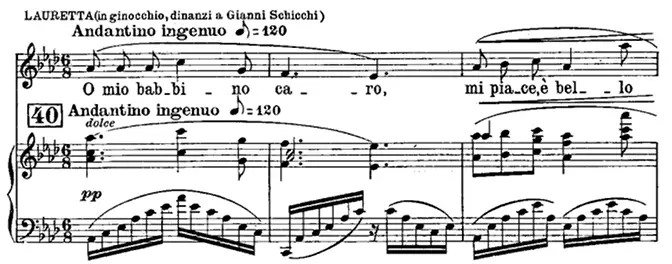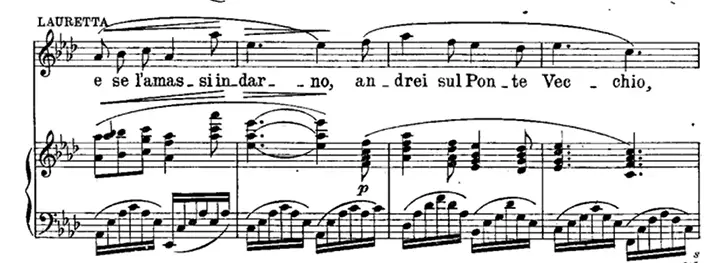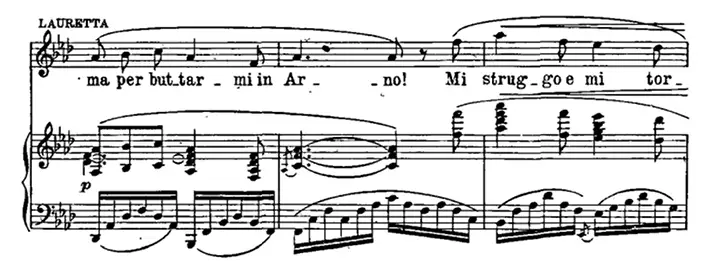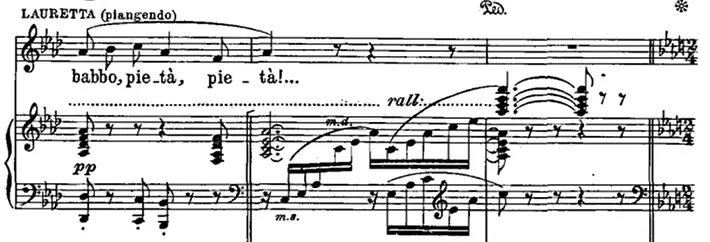O MIO BABBINO CARO – an aria from the opera Gianni Schicchi
The opera guide of Puccini’s aria O MIO BABBINO CARO
Read Interesting facts and hear great YouTube Videos about the famous aria “O MIO BABBINO CARO”.
If you want to hear more about the opera GIANNI SCHICCHI, click on the link to the opera portrait
The aria – synopsis and background
Synopsis: Rinuccio had hoped that the deceased uncle had bequeathed something to him, because he can only marry his lover Lauretta, the daughter of Gianni Schicchi, with the help of the legacy. But his uncle bequeathed the estate in his will to the church. Rinuccio has the idea: only Gianni Schicchi can help here. He has already called for him. His relatives are shocked, they want nothing to do with such a person. Rinuccio gives a flaming speech for Gianni Schicchi. Yes, he is a stranger and he is crafty, but only he can save them with his cunning. Gianni Schicchi enters the house accompanied by his daughter Lauretta. Rinuccios aunt wants to chase him away together with his daughter. Schicchi has only contempt for this kind of people and wants to leave, deeply insulted. Lauretta and Rinuccio are desperate and see their wedding disappear. Rinuccio appeals to his relatives to trust Schicchi and Lauretta asks her father to stay, otherwise she wants to throw herself in the Arno river.
The aria is very simple but still deserves to be famous. The expression mark is “ingenuo”, which means naive, trustful. The aria must be sung from the heart without artificial pathos. Of course there is also a portion of cunning behind it, because the young woman knows how to soften her father’s heart. Lauretta sings her melody on her knees in front of her father. The “Caro” must be filled with love.
With a big but velvety crescendo and octave jump to the high A flat “e se l’amassi indarno” (“and won’t you give it to me”) with beautiful clear vowels Lauretta shows her teeth to all.
A resigned and dramatic “per buttarmi in Arno” (“I throw myself in the Arno”) is followed by the loudest part of the aria, mi struggo o tormento ( “I fret and suffer torments”).
After this loud passage follows immediately a beautiful “O dio” in pianissimo and after the death wish an irresistible, almost sweet babbo, pietà, pietà ( “Daddy, have pity, have pity”) which must almost sound like a prayer. A naïve heartwarming prayer of a young woman.
The aria – the text of O MIO BABBINO CARO
O mio babbino caro,
mi piace, è bello bello,
vo’andare in Porta Rossa
a comperar l’anello!
Si, si, ci voglio andare!
E se l’amassi indarno,
andrei sul Ponte Vecchio
ma per buttarmi in Arno!Mi struggo e mi tormento,
O Dio! Vorrei morir!
Babbo, pietà, pietà!
Oh my dear papa
I like him, he is so handsome.
I want to go to Porta Rossa
To buy the ring!
Yes, yes, I want to go there!
And if my love were in vain,
I would go to the Ponte Vecchio
And throw myself in the Arno!
I am pining, I am tormented!
Oh God, I would want to die!
Father, have pity, have pity!
Written for a “lyrical soprano”
The role of Lauretta is written for a lyrical soprano. The lyrical soprano must have a voice with a warm timbre and must be able to convince with a bell-like sound in the high register. This should be colourful and must not sound forced. The middle register must be rich.
Famous interpretations of O MIO BABBINO CARO
There are dozens of interpretations. A selection is difficult. Caballé’s interpretation is famous and perhaps the most beautiful … The high notes flow breathtakingly, the mood is almost ethereal.
O mio babbino caro – Caballé
Impatience and drama resonate in this recording of Maria Callas. Urgency is almost physically palpable.
O mio babbino caro – Callas
The interpretation by Elisabeth Schwarzkopf is very touching. The most intimate of the recordings.
O mio babbino caro – Schwarzkopf
And as last version Anna Netrebko’s interpretation.
O mio babbino caro – Netrebko
A BONUS version with beautiful paintings of Florence
Peter Lutz, opera-inside, the online opera guide to the Aria “O MIO BABBINO CARO” from the opera Gianni Schicchi from Giacomo Puccini.








Leave a Reply
Want to join the discussion?Feel free to contribute!